GammaTech DURABOOK S15AB
Using state-of-the-art technology, GammaTech solves the challenge of creating a lighter, thinner laptop without sacrificing performance or battery life.
(by Conrad H. Blickenstorfer; photography by Carol Cotton; see summary review here)
For the past six years or so we've been hearing a lot about the supposed "Post PC" era, i.e. a time where conventional personal computers are increasingly relegated into insignificance, making way for a wonderful new world of tablets and big phones. That kind of thinking gave rise to Windows 8, an operating system seemingly intent on making the use of a "conventional" PCs as difficult as possible. As is, of course, all those many hundreds of millions of office workers around the world didn't suddenly ditch their PCs and laptops for tablets. They kept and keep on using them, and most likely they will for some time to come. Even out there in the field, tablets and phones haven't replaced the more conventional laptop.
The folks at GammaTech know that, fortunately, and they haven't forgotten about the need for good, reliable, state-of-the-art laptops that can also take a beating. And so industrial, enterprise and government users the world over can rejoice in the knowledge that at least some technology companies won't leave them down. The latest DURABOOK, introduced late 2015, is a good reminder of that.
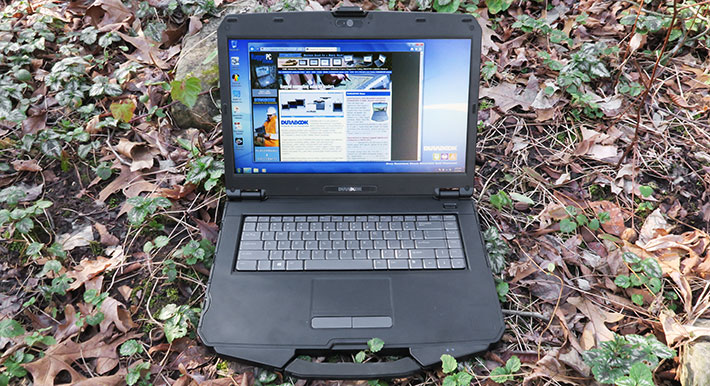
The DURABOOK S15AB
The newcomer is an addition to GammaTech's existing lineup that already includes the semi-rugged DURABOOK SA14 and the DURABOOK S15H. Interestingly, each is a distinctly different design. As of this writing (March 2016), all three notebooks are listed as available on the GammaTech website. We have conducted full reviews of both the SA14 (see here) and the S15H (see here). The table below shows some of the major specs and differentiators between the three most recent full-size DURABOOKs:
|
DURABOOK semi-rugged/rugged lineup
|
|
DURABOOK model
|
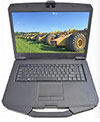
|
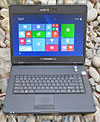
|
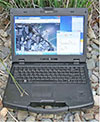
|
|
DURABOOK model
|
S15AB
|
S15H
|
SA14
|
|
Introduced
|
2015
|
2014
|
2013
|
|
Size (inches)
|
14.7 x 10.7 x 1.1
|
14.6 x 10.9 x 1.5
|
13.5 x 9.7 x 1.9
|
|
Weight
|
5.7 lb
|
6.6 lb
|
7.8 lb
|
|
Intel Processor
|
Broadwell (G5)
|
Haswell (G4)
|
Ivy Bridge (G3)
|
|
Thermal Design Power (TDP)
|
15 watts
|
35 watts
|
37 watts
|
|
Display size (inches)
|
15.6 (1920 x 1080)
|
15.6 (1920 x 1080)
|
14.0 (1366 x 768)
|
|
Battery capacity
|
59 watt-hours
|
87 watt-hours
|
87 watt-hours
|
|
Std. battery life
|
8.5 hrs.
|
7.5 hrs.
|
6-7 hrs.
|
|
Drop spec
|
2.5 feet
|
2.5 feet
|
3.0 feet
|
|
Starting price
|
US$1,999
|
US$1,399
|
US$1,499
|
In essence, the trend over the past two years has been to larger displays (from 14 to 15.6 inches), higher resolution (from 1366 x 768 pixel to full HD 1920 x 1080 pixel), a progressively slimmer profile (from 1.9 to 1.1 inches), progressively lower weight (from 7.8 to 5.7 pounds), and always using CPUs from the latest available generation of Intel Core processors.
What has changed is the type of processor type GammaTech picked for their latest model. Both the SA14 and the S15H used "standard voltage" processors with a thermal design power, or TDP, of 35 watts. The 35 watts represents the maximum amount of heat the computer must be able to get rid of, and it's also used by Intel as a rough performance indicator.
The new S15AB, however, uses a "ultra low voltage" processor from Intel's "Broadwell" 5th generation of CPUs with a TDP of just 15 watts. That means that the chip generates less than half the amount of heat as the chips used in the earlier DURABOOKs. The more efficient operation of the new chip means it uses less power. And so GammaTech gave the new S15AB a battery with a third less capacity than that of the two predecessor models. But even with the smaller battery, the S15AB is actually rated to get longer battery life than the older models!
The question that immediately comes to mind, of course, is whether the significantly more frugal processor will make the new S15AB slower than the two older models with the standard voltage chips? That question will be answered in this review.
Design, look and feel
The table shows that each successive new GammaTech notebook weighed a pound less than the previous one. 5.7 pounds is remarkably little for a tough full-size notebook, and we're sure many customers will appreciate the lower weight. The GammaTech DURABOOK S15AB is a timely laptop solution for those who need more durability and ruggedness than the generally rather fragile consumer notebooks provide, but still at a reasonable price. But what's "reasonable" these days? The starting MSRP of the DURABOOK S15AB is US$1,999. That's considerably less than conventional vertical market rugged notebooks cost, but it's also a hefty $600 more than the S15H started at. Could this lead to price resistance?
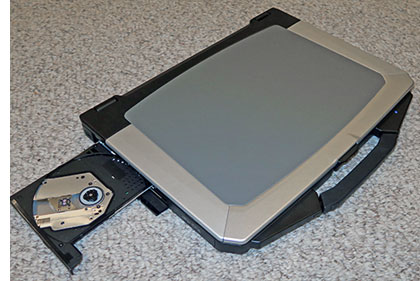 That depends on expectations. The DURABOOK S15AB IS an impressive full-size notebook computer designed to be considerably tougher and more durable than standard consumer notebooks, but without the extra heft and cost of a fully rugged design.
That depends on expectations. The DURABOOK S15AB IS an impressive full-size notebook computer designed to be considerably tougher and more durable than standard consumer notebooks, but without the extra heft and cost of a fully rugged design.
Compared to fully-rugged laptops, the S15AB is only spill-proof rather than fully water-proof, and it's built to be tough enough rather than like a tank. It does have a sturdy magnesium-alloy case, a wide-format display that at 15.6 inches is much larger than those of most fully rugged notebooks, and it has the expected state-of-the-art connectivity and functionality. Under the hood works a super-efficient member of Intel's 5th generation of Core processors. The idea of the low-voltage design is to provide an economical turbo 4-cylinder engine rather than a big lumbering V8 gas guzzler.
While the DURABOOK S15AB remains a full-size notebook with a big screen, it's significantly slimmer than its predecessor. Measuring 14.7 x 10.7 x 1.1 inches, the S15AB occupies 27.3% less volume than the S15H, and has also dropped about 15% weight. While even 1.1 inches isn't super-thin, the S15AB feels quite handy and manageable; it's not a monster like some older semi-ruggeds. It is also a rather elegant design, albeit in an almost needlessly understated way. We wouldn't have minded a bit more swagger and perhaps an impressive DURABOOK logo. But overall, the black bottom part goes well with the black/matte-silver/gray styling of the topside.
Below you can see the GammaTech DURABOOK S15AB from the top and all four sides. The magnesium alloy case is light, yet, GammaTech points out, many times stronger than ABS plastic. Even in its newly slenderized form, this DURABOOK doesn't flex and creak like most plastic consumer laptops. The LCD case hinges offer a trust-inspiring degree of resistance when opening and closing the computer. And when you close the lid, a small spring-loaded metal latch snaps into place, securing the LCD case in place when in closed position. To open the notebook again, you push on the latch.
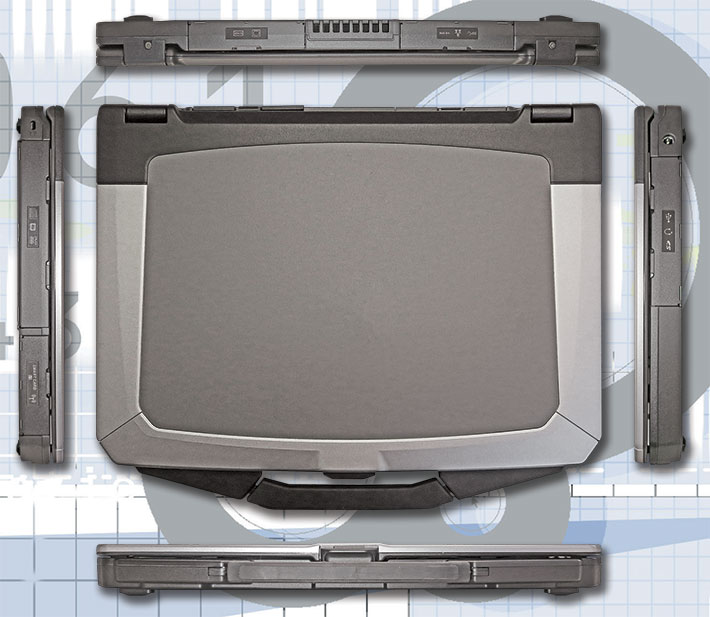
Ports and connectivity are located on the left and right side and the front of the computer. Unlike on the older S15H where almost all ports were fully exposed, the S15AB uses protective plastic port covers all around. These are not of the sealing kind; they are primarily there for physical impact protection.

On the left side (above), from left to right, you first find a Kensington lock slot (yes, physical security is still a good thing), the laptop's optical drive, the Smart Card reader, and then a RF slide-switch to turn all radios on or off.

On the right side, from left to right, is an SD card reader that can handle SDXC (which has a theoretical limit of 2TB!) as well as Mini-SD and Micro-SD cards via adapters, an earphone jack, two standard USB 2.0 ports, and then the power plug.

Along the backside, again from left to right, there are two USB 3.0 ports, an RJ-45 gigabit LAN jack, and an HDMI output port (which supports up to 4k resolution — 3840 x 2160) under one cover, then the heat exchange exhaust grille, then another cover underneath of which are a VGA port and a DB9 legacy serial port.
The front features the nicely design and fully integrated rubber handle, as well as the unit's two speakers.
Below you can see the bottom of the DURABOOK S15AB with its access covers removed and battery removed. Both covers are made of thin aluminum and held in place with screws. The larger of the two covers has air vents, again indicating that this is a spill-resistant rather than a water-tight design.
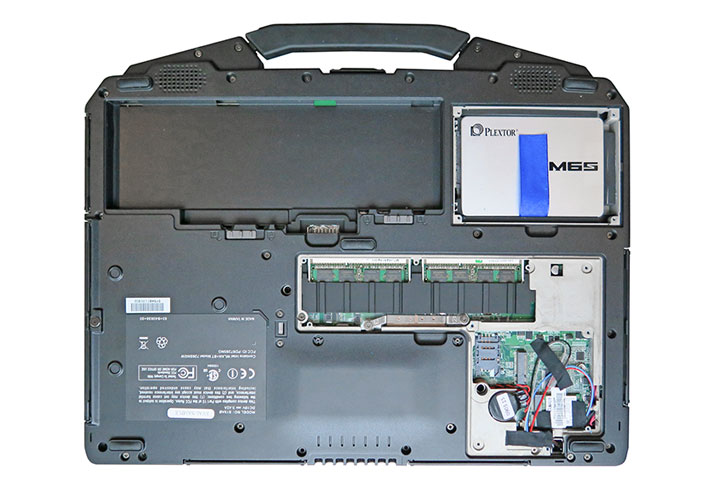
Below you can see the 7.4 Volt/ 8,000mAH Lithium Polymer battery that's only 3/8th of an inch thick. It neatly snaps flush into the back of the system and is secured in place by a couple of sliders. This is a much smaller power pack than the massive 86.6 watt-hour battery in our last S15H review unit. It's more powerful than the smallish netbook-style snap-in battery of the old S15C though, and according to Gammatech enough to power this svelter and more economical DURABOOK a full hour longer than the big battery in the S15H.
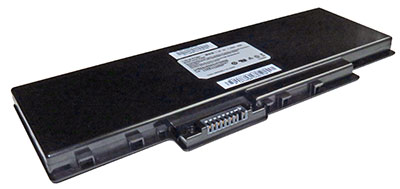 On the upper right is the storage compartment that houses the hard disk. Only, in our eval unit it wasn't a hard disk anymore, but a solid state disk. That makes it lighter, faster, and much more resistant to shocks than conventional rotating hard disks. GammaTech still offers hard disks up to 1TB capacity, and rotating media remains less expensive and offers higher capacity. But if additional ruggedness and maximum performance are issues, an SSD brings substantial benefits.
On the upper right is the storage compartment that houses the hard disk. Only, in our eval unit it wasn't a hard disk anymore, but a solid state disk. That makes it lighter, faster, and much more resistant to shocks than conventional rotating hard disks. GammaTech still offers hard disks up to 1TB capacity, and rotating media remains less expensive and offers higher capacity. But if additional ruggedness and maximum performance are issues, an SSD brings substantial benefits.
The big compartment in the lower right provides access to the unit's two RAM memory connectors. A black rubber boot provides protection from impact and contact. There's also access to the S15AB's two miniPCIe slots, one half size and occupied by an Intel Wireless LAN and Bluetooth 7265NGW module, and a full-size one for use with an optional WWAN mobile broadband card. For that, there's also a SIM Card caddy.
We didn't disassemble the DURABOOK further, but even a brief look inside the two service compartments reveals the high degree of quality and design/manufacturing expertise that went into the magnesium-alloy chassis and case of this laptop, something we've come to expect from GammaTech. And just like with the S15H, one might argue that the impressive internal strength and sophistication of this machine should also be more visibly reflected in its exterior.
Keyboard and touchpad
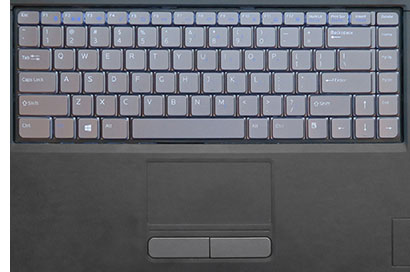 The DURABOOK S15AB's keyboard is full-scale and has 86 keys. The key design is standard notebook (as opposed to the "chiclet" style keys often found in rugged machines) and the keys are dark-gray with thin white letters, numbers and symbols. Functions are indicated in blue. Fonts, font weight and overall design are subdued and elegant, and look great. The keyboard has a backlight that toggles on and off.
The DURABOOK S15AB's keyboard is full-scale and has 86 keys. The key design is standard notebook (as opposed to the "chiclet" style keys often found in rugged machines) and the keys are dark-gray with thin white letters, numbers and symbols. Functions are indicated in blue. Fonts, font weight and overall design are subdued and elegant, and look great. The keyboard has a backlight that toggles on and off.
Below the keyboard is the unit's capacitive touch pad. It is a properly sized and flush-mounted affair with two large and very responsive mouse buttons in front of it.
The touch pad is a pleasure to use, but it can't be operated with gloves on. It does pick up through some materials, like suede or other thin materials, and there are now gloves with special fingerpads so they work with capacitive displays and pads. Another possibility is special touchscreen glove contacts like those available from GloveTacts.
Performance
DURABOOKs usually have two or three available processors to choose from, but for now, GammaTech offers the S15AB with just one, an Intel Core i5-5200U. For the average consumer that means "Intel Inside" (what else could it be these days?), Core means a good high-end processor and not one of those bargain basement Celeron chips, and i5 means not the top-of-the-line i7, which would be good but costs extra.
 Few RuggedPCReview.com readers will look at things in such a simplistic manner, but by now Intel offers such a vast variety of different processors — several hundred — that some commentary is in order.
Few RuggedPCReview.com readers will look at things in such a simplistic manner, but by now Intel offers such a vast variety of different processors — several hundred — that some commentary is in order.
It seems like only yesterday that Intel bid good-bye to the old Duo chips and launched the new Core processors with their i3/i5/i7 good-better-best differentiation. Since then we've seen the second generation of Core processors ("Sandy Bridge"), then the third ("Ivy Bridge"), then the fourth ("Haswell"), then the fifth ("Broadwell"), and already the sixth ("Skylake"). There are still Pentiums and Celerons, but they can now be part of different processor lines, and then there are various strains of evolved Atom chips. Core processors are still the high end, and "extreme" versions can cost as much as US$1,100 (like the i7-4930MX). However, even a lowly US$17 Atom Z3735F can run Windows, and quite well.
That all said, where does the i5-5200U in this DURABOOK fit in? Well, it's part of the Broadwell 5th generation of Core processors. Many consumer notebooks are now using 6th gen "Skylake" chips, but Broadwell is by no means obsolete. In fact, in vertical and industrial markets wit their longer product cycles, Broadwell is still very much considered state-of-the-art (there are many vertical market products that still use 2nd, and 3rd generation Core chips).
But why the switch from the powerful "standard voltage" chips in earlier DURABOOKs to an "ultra-low voltage" chip in this latest DURABOOK? Because by now Intel's Core processors are so efficient that they can reach very high peak performance even with lower voltages and much lower Thermal Design Powers. How can that be so? The best analogy is the automotive one where small turbocharged 4-cylinder engines can reach very high performance thanks to advanced technology and superior thermal management, while still providing excellent fuel economy under normal operating conditions. The idea is that, likewise, an advanced late-model low-voltage Intel Core chip can match the peak performance of an older and much less efficient processor, and can actually get longer battery life from a small battery. Which is exactly what many customers want: good performance, low weight, slim profile, long battery life.
To see if this is actually possible, we ran our standard benchmark suite, Passmark Software's PerformanceTest 6.1, that runs about 30 tests covering CPU, 2D graphics, 3D graphics, memory, and disk and then computes scores for each category and an overall PassMark score. We also ran our second benchmark suite, CrystalMark, for confirmation, single core performance, and additional information. For comparison, in addition to the S15AB's S15H and S15C predecessors which ran on standard voltage chips, we also included benchmark results of a couple of fully-rugged reference machines that both also switched to ultra-low voltage chips: The big Dell 14 Rugged Extreme notebook, and the latest version of the Getac V110 convertible. The latter two are not direct competitors of this DURABOOK, but simply show where the test machine fits into the current performance landscape.
The results are as follows:
|
Gammatech DURABOOK S15AB Benchmarks and Comparisons (PassMark 6.1)
|
|
PERFORMANCE COMPARISON
|
Gammatech
|
Gammatech
|
Gammatech
|
Dell
|
Getac
|
|
Model
|
S15AB
|
S15H
|
S15C
|
14 Rugged Extreme
|
V110
|
|
Year tested
|
2016
|
2014
|
2011
|
2015
|
2015
|
|
Processor Type: Intel
|
Core i5
|
Core i5
|
Core i5
|
Core i5
|
Core i7
|
|
Processor Model
|
5200U
|
4300M
|
M460
|
4300U
|
5600U
|
|
CPU Speed
|
2.20 GHz
|
2.60 GHz
|
2.53 GHz
|
1.90 GHz
|
2.40 GHz
|
|
Turbo Speed
|
2.70 GHz
|
3.30 GHz
|
2.80 GHz
|
2.90 GHz
|
3.00 GHz
|
|
Thermal Design Power (TDP)
|
15 watts
|
37 watts
|
35 watts
|
15 watts
|
15 watts
|
|
CPU Mark
|
3,526.7
|
4,375.4
|
949.3
|
3,522.0
|
4,084.8
|
|
2D Graphics Mark
|
518.4
|
613.5
|
280.3
|
474.7
|
527.3
|
|
Memory Mark
|
1,430.4
|
1,774.7
|
701.0
|
1,144.1
|
1,148.4
|
|
Disk Mark
|
3,655.5
|
883.8
|
520.5
|
3,964.6
|
3,718.3
|
|
3D Graphics Mark
|
462.8
|
563.4
|
308.1
|
484.3
|
360.3
|
|
Overall PassMark
|
2,071.6
|
1,831.1
|
562.8
|
2,078.4
|
2,170.4
|
|
CM ALU
|
41,280
|
51,183
|
34,491
|
42,120
|
47,195
|
|
CM FPU
|
37,524
|
50,385
|
32,924
|
39,941
|
42,951
|
|
CM MEM
|
44,983
|
50,614
|
19,390
|
43,971
|
20,216
|
|
CM HDD
|
40,383
|
22,882
|
8,049
|
42,880
|
41,329
|
|
CM GDI
|
17,033
|
19,791
|
9,538
|
16,050
|
15,651
|
|
CM D2D
|
6,735
|
8,534
|
2,017
|
14,219
|
5,987
|
|
CM OGL
|
8,184
|
15,858
|
2,424
|
32,989
|
11,605
|
|
Overall CrystalMark
|
192,122
|
219,247
|
108,833
|
231,170
|
192,170
|
What can we learn from these benchmarks? First, when comparing the three GammaTech machines, two things are immediately clear: Progress has been tremendous over the past five years. The new S15AB absolutely trounces the 2011 S15C with its first-gen Core chip, even though the processor in that machine had a nominally higher clock speed and a much higher thermal design power. And compared to the 2014 S15H with its very fast standard voltage Intel Haswell chip, the new S15AB holds its own, even with its ultra-low voltage chip and lower clock speed.
How is that possible when, in essence, Broadwell is just a shrunken version of Haswell, and the Core i5-4300M in the last DURABOOK S15H we tested was actually a bit faster in almost every test? The answer is disk. That machine had a conventional rotating hard disk, whereas our review S15AB came with a blisteringly fast solid state disk. That makes all the difference, and means that overall the new S15AB is the faster machine in most operations, and it even gets longer battery life from a smaller battery.
What do the comparisons to the two reference machines show? The big Dell is also an ultra-low voltage design, albeit one based on a slightly older Haswell chip. There is very little difference in performance between the two, except in one area, and that's certain graphics operations. There, the Dell is much faster, and it's because in addition to its integrated Intel graphics it also has a dedicated, discrete graphics card. The Getac convertible runs a little faster, as one would expect from its slightly higher-end Core i7 chip with slightly faster clock speed.
Overall, the benchmarks showed the DURABOOK S15AB to provide excellent performance. This confirmed the subjective impression we had from using the machine over several weeks.
Power and battery life
Back in the days when we published the Pen Computing print magazine, the battery life of laptop computers was in the 1-2 hour range, and even when we launched RuggedPCReview.com a decade ago, we rarely saw more than 3-4 hours. Today's customers generally expect full-shift operation, and manufacturers deliver. How far we've come.
That said, it wasn't easy. While battery technology has come a fairly long way, it has not kept pace with the far more dramatic increases in processing power. And today's customers want their laptops and tablets sleek and light, and that again is a problem because batteries are quite heavy.
So how does all of this affect the DURABOOK S15AB? Well, GammaTech has been trying different approaches. The 6.5-pound DURABOOK S15C, launched in 2011, had a small 48 watt-hour that only yielded about 3.5 hours of operation. The DURABOOK S15H we tested in 2014 came with the much beefier 87 watt-hour battery that yielded more like 7.5 hours. That was progress, but the machine still weighed a hefty 6.6 pounds and was an inch and a half thick.
With the new S15AB, GammaTech went with a much more frugal low-voltage processor, hoping that Intel's advancements in processor technology would yield similar performance at much lower battery power draw. The result is the much thinner Sa15AB that dropped a pound and now weighs in at just 5.7 pounds. The slender battery only packs 59 watt-hours, and yet GammaTech expects 8.5 hours from this smaller capacity pack.
On Windows-based systems we always run PassMark's BatteryMon utility to measure power draw under various operating conditions. Somehow, as was already the case with the S15H, BatteryMon didn't work on the S15AB, always showing the same draw. Backing into the figures, we concluded that the S15AB drew about 5.4 watts in Windows Power Saver mode, and with the backlight dim. Given the 59 watt-hour battery capacity, that would indicate well over 10 hours between charges, and so GammaTech's 8.5 hour claim should easily be possible.
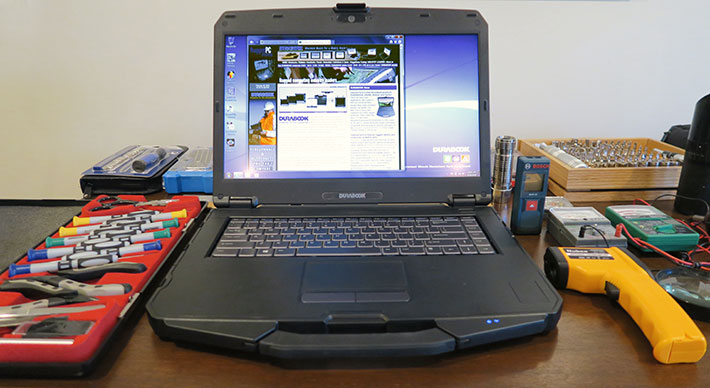
High-definition display
The DURABOOK S15AB's large display measures 15.6 inches diagonally and it uses the full 1920 x 1080 pixel HD resolution, which translates into a wide-format 16:9 aspect ratio. This resolution is also known as 1080p on TVs. The vast majority of big screen TVs use 1080p, although there is now a move underway to 3,820 x 2,160 "4K" resolution.
As is, 1920 x 1080 resolution means there are 141 pixels per inch. That's sharper than the big iMac27 I am writing this review on (109 ppi), sharper than the original iPad (132 ppi), sharper than all the non-retina Apple MacBook Pro and Air models, but not as sharp as most newer consumer tablets, or state-of-the-art smartphones where resolutions are going through the roof (500+ ppi).
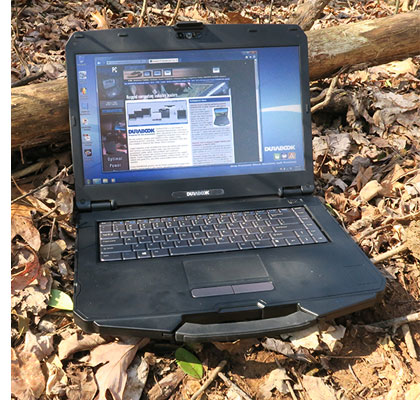 Earlier GammaTech notebooks usually came standard with 1366 x 768 pixel resolution and the company would also offer a 1920 x 1080 option. We're glad that the 1080p screen is now standard as customers, spoiled from their super-sharp smartphones and tablets, no longer consider 1366 x 768 pixel adequate on a display this large.
Earlier GammaTech notebooks usually came standard with 1366 x 768 pixel resolution and the company would also offer a 1920 x 1080 option. We're glad that the 1080p screen is now standard as customers, spoiled from their super-sharp smartphones and tablets, no longer consider 1366 x 768 pixel adequate on a display this large.
Since the display is so important in any laptop, and especially so in one that may well see extended duty outdoors, we'd love to report on the specs and technology of the display, but available information is sparse. GammaTech literature only provides the S15AB screen's size and resolution and nothing more.
In our testing, the S15AB display was quite usable outdoors, which suggests the presence of anti-reflective and perhaps anti-glare coatings as well as an enhanced-brightness LED backlight. Optical coatings and enhanced brightness, of course, are the current recipe for outdoor/sunlight viewability.
As is, what we can report is that the S15AB's display is pleasant, and bright enough for some outdoor use. We also appreciate that the display surface is semi-matte rather than the high gloss of most consumer notebooks. Glossy displays continue to rule in consumer notebooks and tablets because they "pop" indoors and in environments with few reflections, but matte displays are simply better outdoors where they diffuse light in a controlled manner, making it easier to view them under the typically high-contrast outdoor lighting conditions.
A display quality that we consider quite important are the horizontal and vertical viewing angles. The DURABOOK display has an almost perfect horizontal viewing angle, but the vertical one, while wide, is affected by chromatic aberrations and color shifting as you change the viewing angle, and especially when viewing from negative angles. We are glad GammaTech made 1080p standard, and now hope we'll see perfect viewing angles in the next version of the S15 platform.
How rugged is the DURABOOK S15AB?
Quite obviously, the name "DURABOOK" invokes connotations such as "tough," "durable," "reliable," etc., and GammaTech does refer to it as a "rugged notebook." Unfortunately, there are no standards on what exactly defines "rugged" or "semi-rugged" or even "durable" or "business-rugged" or whatever else the industry has come up with. Even the often cited MIL-STD-810G really only describe the procedures for a variety of environmental tests. What it means is that the terms are quite elastic.
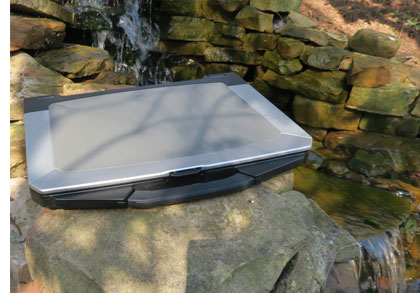 As is, GammaTech really only claims resistance to drops, shock, and spills, and describes the design limits in some detail.
As is, GammaTech really only claims resistance to drops, shock, and spills, and describes the design limits in some detail.
For drops, testing is conducted in accordance with the procedures described in MIL-STD-810G, Method 516.6, Procedure IV. Drops are from a height of 30 inches, which is about the height of a tallish desk, onto 2-inch plywood over concrete. The machine is then dropped once on its six faces (front, back, top, bottom, left, and right) with the display closed and unit turned off. After each drop, the machine must be able to boot. That is not terribly impressive compared to the four (and higher) foot drops onto concrete some of the ruggeds can do, but it's in line with most semi-rugged notebooks available today. Higher drops would require rubber bumpers, adding bulk and thickness.
GammaTech also states shock and vibration resistance in testing similar to MIL-STD-810G, Method 514.6, Procedure I, Category 24 (all materiel - minimum integrity tests), Fig 514.6C-1 (common carrier (US highway truck vibration exposure) which tests resistance to vibration using standard laboratory shakers, slip tables, and fixtures.
In addition, GammaTech claims adherence to ASTM4169, Truck Transport, 11.5.2 Random Test, Assurance Level II. ASTM stands for American Society for Testing and Materials. The D 4169 standard sets tests and requirements for strength, durability and protective capability of packaging. Level II stands for medium test intensities and is most commonly used.
On the sealing front, the DURABOOK S15AB rates an IP5X, where the "5" means the device is protected against dust, but with limited, non-harmful deposits is permitted. The "X" means there is no rating indicating protection against liquids. What this means is that instead of water-proofing the entire housing, which requires a more elaborate thermal design, GammaTech concentrated on spill resistance, which is usually the primary source of damage through liquids.
Summary: The GammaTech DURABOOK S15AB
The Gammatech DURABOOK S15AB, successor to the company's earlier full-size DURABOOKs S15C and S15H, is a notebook computer designed to be tougher and more durable than standard consumer models, but without the extra bulk, weight and cost of a fully rugged design. Compared to earlier versions, this is a lighter, slimmer design with longer battery life.

Weighing in at a manageable 5.7 pounds, the S15AB is just 1.1 inches thick. It still has an internal optical drive, comes with extensive onboard connectivity, and has an integrated carry handle. Built around a very solid magnesium alloy chassis, the S15AB offers a high-quality look and feel.
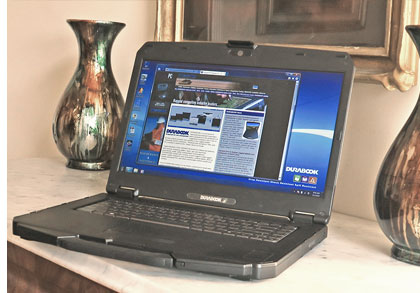 Despite its lower weight and smaller battery, this latest model provides longer battery life (GammaTech claims 8.5 hours) than its predecessors. That is made possible by an ultra-low voltage Intel 5th generation "Broadwell" processor, which in conjunction with a fast solid state disk performed as well as its S15H predecessor equipped with a standard voltage CPU.
Despite its lower weight and smaller battery, this latest model provides longer battery life (GammaTech claims 8.5 hours) than its predecessors. That is made possible by an ultra-low voltage Intel 5th generation "Broadwell" processor, which in conjunction with a fast solid state disk performed as well as its S15H predecessor equipped with a standard voltage CPU.
The DURABOOK S15AB has a large, bright 15.6-inch wide-format display with full 1920 x 1080 pixel HD resolution that remains usable outdoors without much reflection and glare. There is no touch screen. The display surface is matte, which makes it more pleasant to use than a glossy screen. The vertical viewing angle is somewhat limited.
While it's not immediately obvious by the modest ruggedness claims, this DURABOOK is an exceptionally well constructed machine. Its magnesium alloy chassis should hold up for a long time, and there is plenty of shock-mounting as well as plenty of internal protection. However, while the unit can handle spills onto its keyboard and such, it is not waterproof (there are open cooling vents to inside on side and bottom).
With the — for a full-size semi-rugged design — remarkably light and slender DURABOOK S15AB, GammaTech offers a contemporary laptop computer that offers both very good performance and full-shift battery life. And it comes in an attractive, if somewhat understated, package that's significantly tougher than standard consumer laptops and should hold up well in daily use. -- Conrad H. Blickenstorfer, March 2016
|
GammaTech DURABOOK S15AB Specifications
|
| Added/changed |
Added 09/2015, full review 03/2016
|
| Type |
Rugged notebook
|
| Processor |
Intel Core i5-5200U
|
| CPU speed |
2.2GHz (2.7 GHz max turbo)
|
| OS |
Windows 7 Professional, Windows 8.1 Professional, Windows 10
|
| Graphics Controller/Chipset |
Intel HD Graphics 5500 |
| Memory |
Max. 16GB DDR3 in two sockets
|
| Disk/drive |
2.5-inch 500GB/1TB SATA III hard disk or 128GB to 512GB SSD
|
| Display size and resolution |
Semi-matte 15.6" FHD LCD with 1920 x 1080 pixel resolution
|
| Digitizer/Pen |
NA
|
| Keyboard |
86-key, full-scale, spill-proof |
| Multimedia Pocket |
DVD super-multi drive |
| Slots |
1 x SDXC Card, 1 x Smart Card, 1 x SIM card |
| Housing |
Magnesium alloy case, protective port covers
|
| Temperature |
32° to 113°F (0° to +45°C) |
| Humidity |
5 to 95% non-condensing |
| Vibration |
MIL-STD-810G, Method 514.6, Annex Cat. 4, Fig. 514.6C-1; ASTM 4169-08, Truck Transport, 11.5.2 Random test, Assurance Level 2 (Operating)
|
| Enclosure Class |
IP5x, Spill-proof |
| Shock: Functional |
MIL-STD-810G, Method 516.6, Procedure I -- 40g, 11ms Operating |
| Shock: Transit Drop |
2.5 feet MIL-STD-810G, Method 516.6, Procedure IV |
| Altitude |
15,000 feet operating |
| Certifications |
FCC, DOC, CUS, CE, CB |
| Size (inches) |
14.7 x 10.7 x 1.1 inches (375 x 273 x 30 mm) |
| Weight |
5.7 pounds (2.6 kg) as tested |
| Power |
7.4 Volt 7,980 mAh Li-Polymer 59 watt-hours "8.5 hrs."
|
| Communication |
Intel dual-band Wireless AC 7265 802.11ac WiFi, Bluetooth 4.0 Class 1, 4G LTE WWAN, GPS |
| Camera |
2.0 megapixel webcam w/ HD MJPEG support
|
| Interface |
2 x USB 3.0, 2 x USB 2.0, 1 x 10/100/1000 RJ45, 1 x DB9 RS232, 1 x VGA, 1 x HDMI, headphone, microphone, dock
|
Price |
Starting at US$1,999 |
| Web page |
DURABOOK S15AB web page
|
| Spec sheet |
DURABOOK S15AB spec sheet |
| Warranty |
3 years (mail-in); optional 2/3/4/5 year no-fault warranties |
| Contact |
GammaTech USA Headquarters
48303 Fremont Blvd.
Fremont, CA 94538, USA
Tel: (510) 492-0828, (800) 995-8946 tollfree
Fax: (510) 492-0820 |
|






